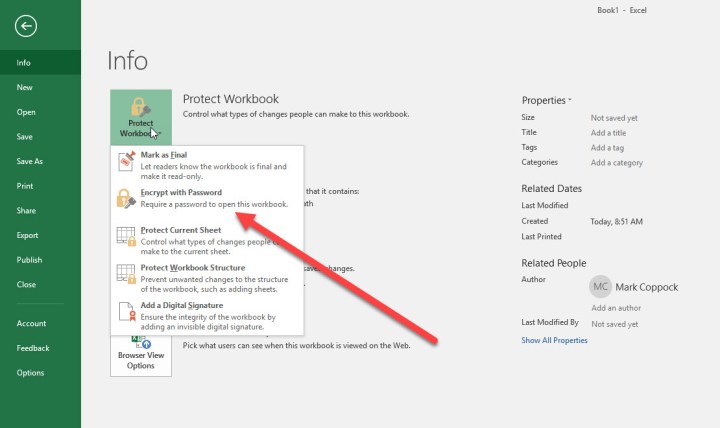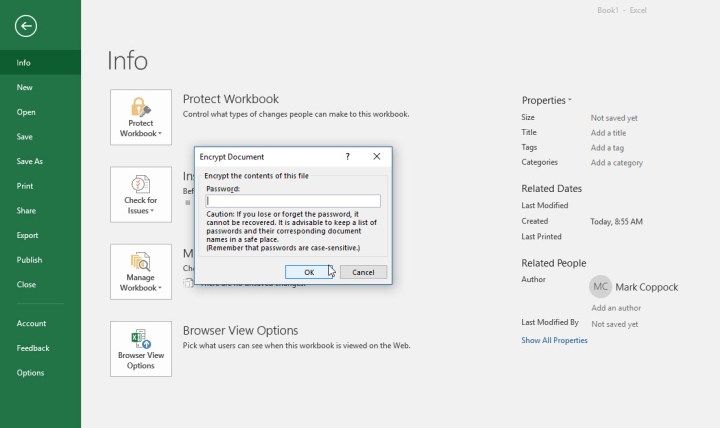How to password-protect an Excel file on Windows and Mac
Sending Excel files containing crucial financial and business data has risks. To add a layer of protection, you should learn to password protect an Excel file.

If you use a computer, you probably have some Microsoft Excel documents on your Mac or PC that you wouldn’t want other people to find and read.
After all, Excel serves not only the average person, but also businesses, government institutions, and millions of other folks worldwide. Whether you’re creating graphs, converting PDFs, or just inputting rows and rows of data, the best way to keep that information safe is to learn how to password-protect an Excel file.
Adding a password
Step 1: In Excel, open the document you want to secure with a password.
Step 2: Click File, followed by Info.
 Mark Coppock / Digital Trends
Mark Coppock / Digital Trends
Step 3: Next, click the Protect workbook button. From the drop-down menu, select Encrypt with password.
Step 4: Excel will then prompt you to type in a password. Pick one that’s complicated and unique and note it down in a quality password manager.
 Mark Coppock / Digital Trends
Mark Coppock / Digital Trends
File encryption
Now that you’ve password-protected your most essential files, it might be worth considering adding extra layers of security to your system. The easiest way to protect a large number of records is to encrypt them. Luckily, encryption programs are not hard to find. Windows 10 Professional users have a built-in encryption utility called BitLocker. Still, if you want to download a free version with customization options for different types of data, you can try the VeraCrypt open source download.
Additional security options
Excel also allows you to apply more customized security options to your file if necessary. It’s important to know what these other options do so you can create the right security for your project. Under Protect workbook, you’ll find several additional features that may prove useful:
Mark as final: This will mark the file as completed, which lets other people know that they shouldn’t make any changes. Using this option will not secure the data behind a password, however, so it doesn’t offer any security.
Protect current sheet: This will guard the currently selected worksheet with a password so that people can’t make any changes or only certain kinds of changes. It’s a handy option if there’s only one sheet in the workbook that you want to protect, and you don’t mind if people can see the info — you just don’t want them messing with anything. You will notice that there’s also an option to do this with Workbook structure, which protects from larger changes to the workbook (like adding a new sheet), unless people have the password.
Add a digital signature: You can guarantee that only you have access to and control over your Excel files by adding a digital signature.
Safeguarding Excel files is a crucial task that many people overlook. There are plenty of safety measures available to ensure that your information remains private and secure, starting with password protection.
Editors' Recommendations
How to clean a laptop screen without scratching it How to downgrade from Windows 11 to Windows 10 How to change your mouse cursor in Windows How to use a blue light filter on your PC or Mac How to schedule an email in Outlook for Mac, Windows, and webJon Martindale is the Evergreen Coordinator for Computing, overseeing a team of writers addressing all the latest how to…
How to easily log in to multiple Gmail accounts at once
Have you found yourself rapidly accumulating Gmail accounts? Between work, school, and any personal accounts you may have created, it's completely reasonable to have three (or more) Google accounts that need to be checked regularly.
How to use cut, copy, and paste keyboard shortcuts in Windows
Are you tired of all the right-clicking just to access simple commands like cut, copy, and paste? Sure, it's not super labor-intensive, but it can get really annoying after a while when you're constantly summoning one of these actions using a mechanical rodent.
If you’re not utilizing shortcut commands, you’re missing out on an easy way to save time and effort. Read on to learn simple commands that combine Control (Ctrl) and other keys to cut, copy, paste, and even undo actions across Windows apps.
Selecting text and moving your cursor (without a mouse)
Spinning wheel? How to stop your Mac from freezing
Tired of your Mac freezing? Try these tips to fix your Mac
A frozen Mac can be incredibly frustrating to deal with, particularly if you're in the middle of doing something important. Don't despair, though: if your Mac is frozen—regardless of whether you're on a Macbook or desktop Mac—there are some steps you can take to resolve the issue.
Try these fixes before throwing the towel in and heading to the Apple Store.

 Koichiko
Koichiko 



































